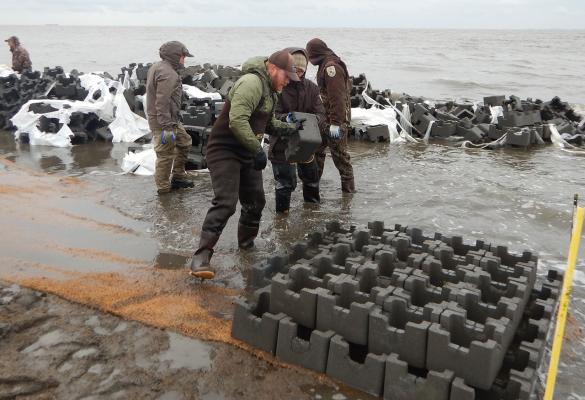Oyster Bed Restoration
Oysters are a type of bivalve shellfish that reside in most coastal regions in the continental United States. As ecosystem engineers, thousands of oysters form large reefs as they attach to a hard substrate or to other oysters (NRC n.d.). Oysters inhabit both salt and brackish waters in coastal areas, providing valuable shelter for other marine species. While oysters spend most of their life cycle attached to a shell, they begin their lives as free-floating larvae (NOAA 2022). Oysters are a cornerstone of coastal ecosystems and fisheries, providing structural protection to the coast as well as improving water quality (NOAA 2022). Additionally, oysters are a staple of the seafood industry, with domestic oyster sales valued at $284.9 million in 2018 (AgMRC 2022). Oyster reefs are on the decline, with 85% of historic global oyster reefs lost (Seavey et al. 2011). This is primarily because of overharvesting, nutrient pollution, and sedimentation (NOAA 2022). To reverse this decline, oyster reef restoration and conservation initiatives attempt to restore oyster populations by lessening harvesting pressure, reducing nutrient loads, and enhancing reef habitats. Common restoration techniques include placing cultch material, installing artificial reef structures, oyster seeding, and oyster aquaculture (Olander et al. 2020a).

Case Studies
Delaware Bay Oyster Restoration Project
Florida Oyster Cultch Placement Project
Half Moon Reef Oyster Restoration Project
Lavaca Bay Restoration, Point Comfort, Calhoun County
MacDill Oyster Reef Shoreline Stabilization
Mile Point Wall Reconfiguration
Mississippi Oyster Cultch Restoration Project
North Cape Shellfish Restoration, Block Island Sound
Olympia Oyster Restoration Project
Oyster Cultch Relief and Reef Configuration
San Francisco Bay Living Shorelines Project
Tools
GEMS Phase I Report: Pyster Reef Restoration
Green Infrastructure Effectiveness Database
Mitigation Ideas: A Resource for Reducing Risk to Natural Hazards
Oyster Habitat Restoration Monitoring and Assessment Handbook
Oyster Reef Resiliency Design Guide
Promoting Nature-Based Hazard Mitigation Through FEMA Mitigation Grants
Likely Benefits and Outcomes
This strategy is likely to achieve these project goals. Click to search for strategies with a similar benefit.
Related Green (natured-based) vs. Gray infrastructure
Explore opportunities to replace or supplement gray infrastructure with green infrastructure options.
